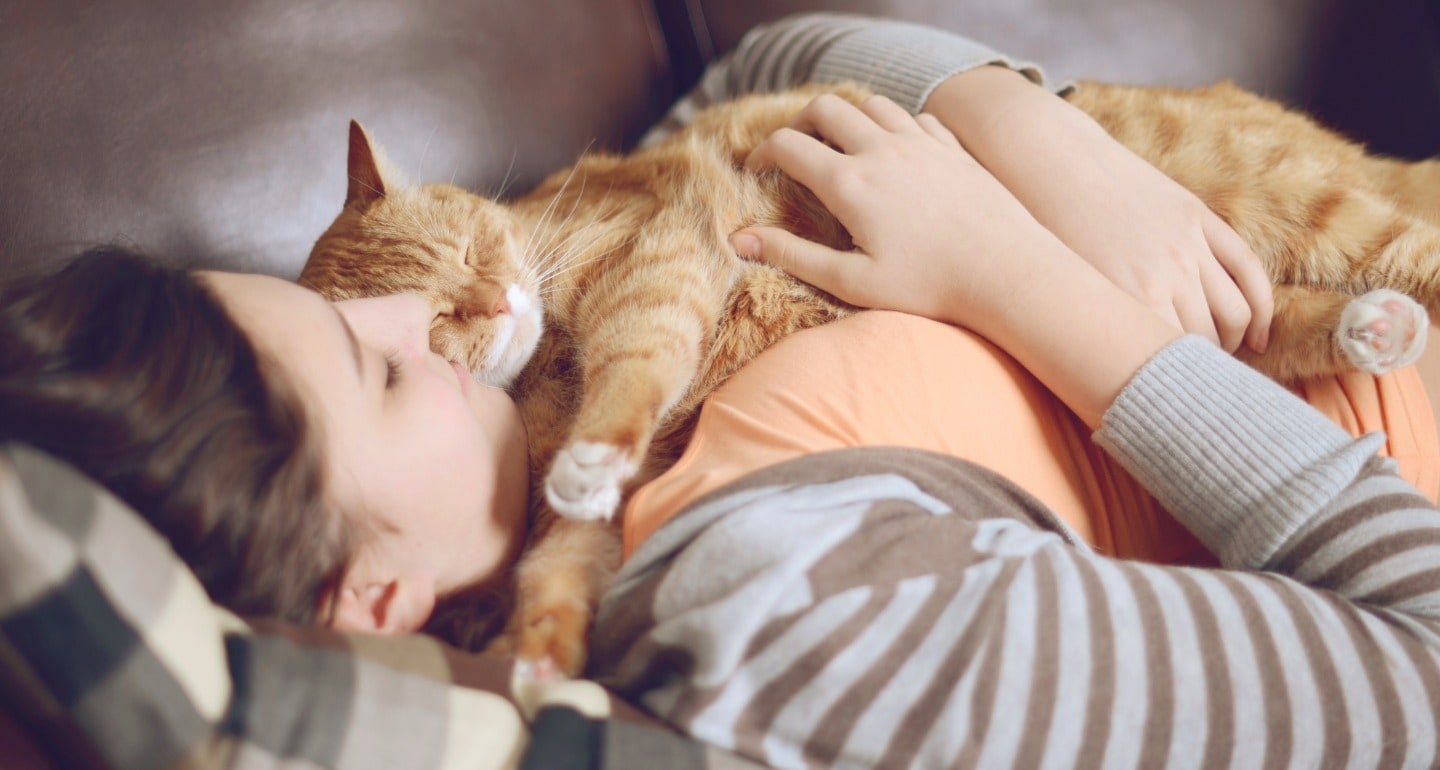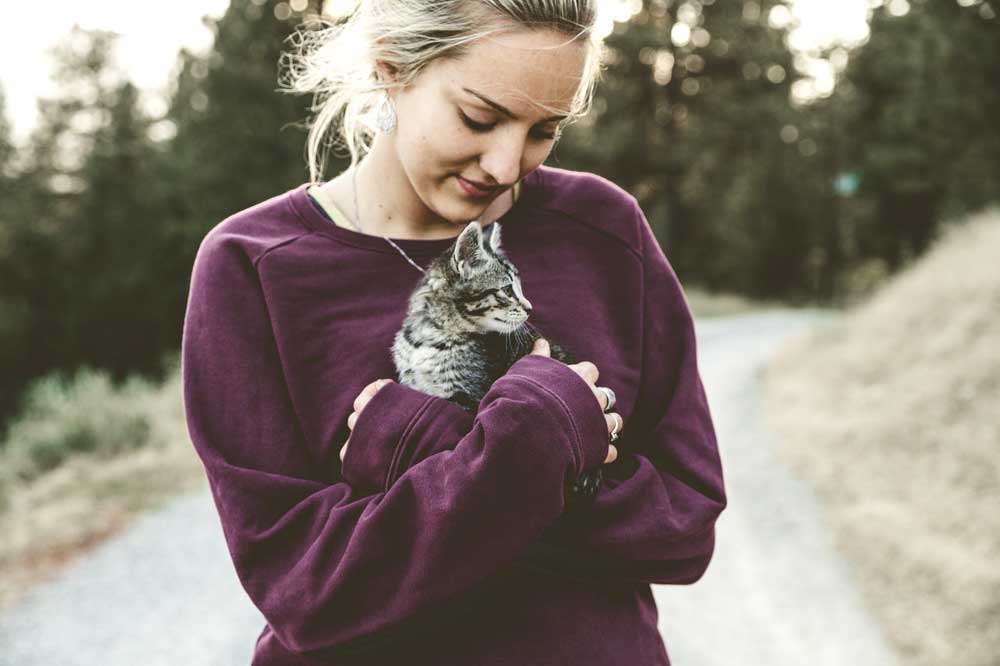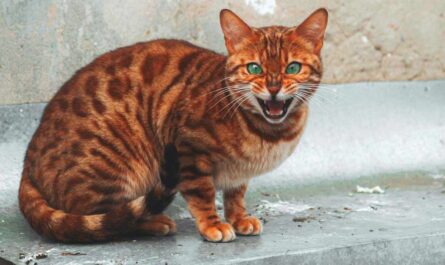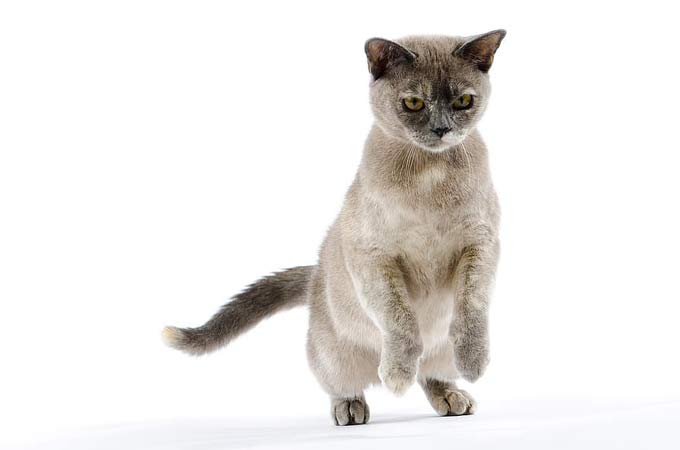Cats sit on your chest, as those mysterious and endearing creatures, often exhibit behaviors that leave their owners both puzzled and charmed. One such behavior is their tendency to sit on their owners’ chests. While it might seem like a simple act, there are numerous reasons behind this affectionate gesture. Understanding these reasons can deepen the bond between cat and owner, providing insights into the complex world of feline behavior. Let’s delve into fourteen possible reasons why your cat might choose to make your chest its favorite resting spot.
Why Do Cats Sit On Your Chest: 14 Possible Reasons
1. Seeking Warmth
Cats possess a natural affinity for warm places, a trait deeply ingrained in their instincts. Your chest, radiating with your body heat, becomes an irresistible sanctuary for them. When a cat curls up on your chest, it seeks more than just physical warmth; it also yearns for the comfort that such a cozy spot provides. This behavior is reminiscent of their wild ancestors, who would seek out warm, sheltered locations to conserve energy and protect themselves from the elements.
By perching on your chest, your cat not only finds a soft and warm place to rest but also taps into a primal need for comfort and security. The combination of your warmth and the soft, rhythmic rise and fall of your breathing creates an ideal environment for relaxation. This simple act of seeking warmth is a clear indication of your cat’s desire for comfort, showcasing the importance of a safe and cozy resting spot in their daily routine.
2. Craving Attention
Despite their reputation for independence, cats have a strong need for attention and interaction with their human companions. When a cat climbs onto your chest, it is making a deliberate effort to place itself at the heart of your focus. This behavior is a strategic move to demand your attention and affection. Cats, like many animals, have developed ways to communicate their needs, and sitting on your chest is a direct and effective method.
This can be particularly common if your cat feels it hasn’t received enough attention or if it simply wants to strengthen its bond with you. The closeness allows for easy petting and cuddling, activities that are essential for a cat’s emotional health. By positioning itself on your chest, your cat is not only seeking physical affection but also reinforcing the social bond between you, ensuring that it remains a cherished and central figure in your life. This need for attention highlights the delicate balance of independence and companionship that defines the unique relationship between cats and their owners.
3. Seeking Safety and Security
The sense of safety and security that your chest provides is another powerful reason why cats gravitate toward this spot. Being close to you, feeling the steady rhythm of your heartbeat and the gentle rise and fall of your breathing, offers a profound sense of reassurance. This is especially crucial for cats that may be anxious or have experienced trauma in their past. The rhythmic motion of your chest can mimic the comforting sensations they felt as kittens nestled against their mothers, fostering a sense of calm and security.
This deep-rooted instinct drives your cat to seek out environments and individuals that offer protection and tranquility. By lying on your chest, your cat finds a safe haven where it can relax and feel at ease. This behavior underscores the importance of a secure environment in your cat’s well-being, highlighting how deeply their need for safety is intertwined with their interactions with you. The comfort and protection your chest provides are vital for your cat’s sense of stability, reinforcing the bond of trust and affection between you.
4. Showing Affection
Cats have a myriad of ways to express their love, and sitting on your chest stands out as one of the most intimate and personal gestures. This action signifies a profound display of trust and affection. When a cat opts to perch on your chest, it’s not merely seeking a vantage point or a comfortable spot; it’s conveying a powerful message of emotional connection. This behavior can be likened to a hug from a human, symbolizing a desire for closeness and bonding. The physical proximity allows your cat to indulge in mutual grooming behaviors, such as head-butting, purring, and even gentle kneading.
These actions are not random but are deeply ingrained ways of reinforcing the affectionate bond between you and your feline companion. The rhythmic purrs, combined with the tender head-butts, serve as a feline equivalent of saying, “I love you.” This interaction nurtures the emotional link, making your bond stronger and more meaningful. It’s an endearing reminder that despite their independent nature, cats have a profound capacity for love and a unique way of showing it.
5. Marking Territory
Cats are inherently territorial creatures, and they have a variety of methods to mark their domain. One of the most personal and significant ways they do this is by sitting on your chest. This behavior is a dual-purpose act that blends affection with a subtle form of possession. Cats have scent glands located on their paws, face, and body. When your cat settles on your chest, it’s not only seeking comfort but also using its scent glands to mark you as part of its territory.
This act of scent marking is a way for your cat to claim you as part of its secure and familiar environment. The scent left behind serves as a comforting reminder to your cat that you belong to it, reinforcing the sense of ownership and safety. This behavior is a testament to how cats integrate their human companions into their territory, blending affection with a deep-seated need for security and familiarity. It’s a loving way for your cat to say that you are an essential part of its world.
6. Comfort and Contentment
The level of comfort a cat experiences when lying on your chest is profound and cannot be overstated. This position allows your feline friend to completely relax, enveloped in your warmth and soothed by the gentle rhythm of your heartbeat and breathing. For many cats, your chest becomes the ultimate haven of comfort, a place where they can truly unwind and feel at peace. This sense of contentment is a clear indicator of a happy and healthy cat, one that feels secure and loved in its home environment.
The physical closeness not only offers a sense of warmth but also facilitates gentle strokes and pets, which further enhance your cat’s well-being. The combination of these soothing elements creates an ideal scenario for your cat to relax, leading to moments of pure contentment. The serene and tranquil moments spent on your chest are a testament to the bond you share, highlighting the mutual affection and the deep sense of security your cat feels in your presence. This level of comfort and contentment underscores the importance of a safe and loving home for your feline companion, contributing significantly to its overall happiness and health.
7. Enjoying Your Scent
Cats possess an extraordinary sense of smell, far more sensitive than that of humans, and they find great comfort in familiar scents. Your unique scent is particularly soothing for them, providing a sense of safety and belonging. When your cat sits on your chest, it immerses itself in your distinctive aroma, which reinforces the bond between you. This olfactory connection is deeply comforting, as your scent symbolizes home, security, and affection.
The presence of your scent can significantly reduce anxiety and stress in your cat, creating a tranquil atmosphere that helps it feel at ease. The mingling of scents is also a way for your cat to strengthen its emotional connection with you, as smell plays a crucial role in their perception of the world. This behavior showcases how important you are to your cat, highlighting the role of familiar scents in fostering a sense of peace and reassurance in their everyday life.
8. Listening to Your Heartbeat
The gentle, rhythmic sound of your heartbeat serves as a powerful source of comfort for cats. This sound harkens back to their early days as kittens when they would nestle close to their mother, feeling her warmth and hearing the steady beat of her heart. For cats, particularly those who are young or have a nervous temperament, the heartbeat provides a calming, almost hypnotic effect.
Sitting on your chest allows them to be close to this soothing rhythm, which acts as a natural lullaby, helping them relax and feel secure. The steady beating of your heart can help alleviate anxiety, making your presence a calming and reassuring influence in their environment. By seeking out the sound of your heartbeat, your cat is tapping into a primal instinct for comfort and safety, demonstrating how deeply rooted this need for auditory reassurance is in their behavior.

9. Seeking Higher Ground
Cats have an instinctual desire to seek higher vantage points, a trait inherited from their wild ancestors. This behavior stems from the need to observe their surroundings from a safe and strategic position, allowing them to spot potential prey or threats. When your cat sits on your chest, it gains a slightly elevated viewpoint, which satisfies this instinctive need for surveillance. Although your chest isn’t significantly higher than other surfaces, it still offers a better perspective than being on the floor.
This elevated position gives your cat a sense of control and awareness, making it feel more secure. The desire to be in a higher place is a fundamental aspect of feline behavior, reflecting their natural instincts to stay vigilant and in command of their environment. By sitting on your chest, your cat not only enjoys a comfortable resting spot but also fulfills its innate need to oversee its surroundings, reinforcing its sense of safety and control in your presence.
10. Mimicking Kitten Behavior
When cats sit on your chest, they often exhibit behavior reminiscent of their kittenhood. As young kittens, they spent significant time nestled against their mother’s chest, finding warmth, comfort, and security in her presence. This early experience leaves a lasting impression, and even as adults, cats may seek to replicate that comforting environment. Your chest, warm and softly moving with your breath, becomes a surrogate for their mother’s comforting presence.
By curling up on you, they are tapping into those deep-rooted instincts that provided them with a sense of safety and belonging as kittens. This behavior allows them to relax fully and feel connected to you on a primal level. The familiarity of the position, combined with the soothing sensations, helps your cat feel secure and content, evoking the same feelings of comfort they had when they were young and nestled against their mother. This instinctual behavior underscores the enduring impact of early life experiences on a cat’s behavior throughout its life.
11. Reducing Anxiety
Cats, much like humans, can experience bouts of anxiety and stress. Sitting on your chest provides them with a safe and comforting space that significantly alleviates these feelings. The proximity to you offers a blend of warmth, rhythmic sounds, and the security of being close to a trusted companion. This combination acts as a potent anti-anxiety measure, particularly beneficial for cats suffering from separation anxiety or those who have endured traumatic experiences.
The steady rise and fall of your chest, coupled with the rhythmic beat of your heart, creates a soothing environment that helps to calm their nerves. Your presence serves as a reassuring anchor, offering a sense of stability and love. This anxiety reduction is crucial for their overall health and well-being, as chronic stress can lead to a host of physical and behavioral issues. By sitting on your chest, your cat is seeking out a natural remedy to its anxiety, finding solace and peace in the closeness of a beloved human.
12. Seeking Emotional Connection
Cats are known for forming deep and meaningful emotional bonds with their human companions. When a cat chooses to sit on your chest, it is seeking not just physical closeness but an emotional connection as well. This position allows for direct and intimate interactions, such as petting, talking, and eye contact, which are vital in strengthening the bond between you and your cat. The physical closeness provides them with a sense of security and reassurance, reinforcing their trust and affection for you. Business – Money Making – Marketing – E-commerce
This behavior is a clear manifestation of the strong emotional ties your cat feels, showcasing its need for closeness and affection tangibly. By sitting on your chest, your cat is expressing its desire to be near you, to feel loved, and to offer love in return. This interaction is mutually beneficial, fostering a deeper connection and enhancing the sense of companionship. The emotional connection sought by your cat underscores the profound and complex relationships they can form with their human friends, highlighting their capacity for love and emotional intimacy.
13. Enjoying the Rhythm of Breathing
Cats find great comfort in the gentle rise and fall of your chest as you breathe. This rhythmic motion can be incredibly soothing, akin to the sensation of being gently rocked to sleep. For cats, especially those with a close bond to their owners, this movement provides a steady and calming influence that helps them relax. The predictability of your breathing pattern offers a sense of stability and security, creating a perfect environment for rest and contentment.
This behavior is a testament to the deep connection between you and your feline friend, as they seek out this comforting motion to feel more connected and at peace. The gentle rise and fall of your chest serve as a reassuring presence, reminiscent of the safe and nurturing experiences they had as kittens. This rhythmic motion not only helps them relax but also reinforces the bond of trust and affection they have for you, making your chest a favored resting spot.
14. Demonstrating Trust
When a cat chooses to sit on your chest, it’s showcasing a profound level of trust. This position exposes them to a vulnerable state, making it a significant display of confidence and security in your presence. Over time, through consistent and positive interactions, your cat has come to view you as a haven. Allowing themselves to rest in such an exposed and intimate position indicates that they feel completely protected and at ease with you. Cat accessories on Amazon
This behavior is one of the clearest signs of a strong and trusting bond between you and your cat. The act of sitting on your chest, where they can be most vulnerable, highlights their deep trust in you and their belief that you will keep them safe. It’s one of the highest compliments a cat can give, demonstrating that they feel an unwavering sense of security and affection in your presence. This trust is the foundation of a healthy and loving relationship, reflecting the mutual respect and care that defines your connection.
Other Interesting Articles
- Cat Flu: Symptoms, Medicine, Treatment, Text Kit, Prevention
- Cat Herpesvirus 1 (FHV-1): Causes, Symptoms, Treatment
- Do Cats Enjoy Mating? A Guide To Feline Sexual Behavior
- Benefits of a High-Protein Diet for Your Cat: A Complete Guide
- How Many Kittens Can A Cat Give Birth To: When To Worry
- Why is My Cat Drinking Much Water All of A Sudden? To-Dos
- Cat Dystocia (Difficult Birth): Causes, Symptoms, Treatment
- 23 Signs That Indicate Something is Wrong with Your Cat
- Cat Eyes Signs: 15 Things Your Cat Is Saying With Its Eyes
- How Cat Eyes Work: How to Care for Your Feline’s Eyes
- Why Does My Cat Sit On My Shoulder? Reasons, To-Dos
- Why is My Cat So Clingy? Behavior, Reasons, Solutions
- Cat Vomiting: Types, Causes, Symptoms, Treatments, Cure
- Feline Estrous Cycle: What To Expect When A Cat Is in Heat
- Weight Gain in Cats: Obesity Signs, Causes & What to Do
- 13 Ways to Tell if A Cat is Pregnant: Signs, Behavior, Guide
- Cat Pregnancy: Signs, Nipples, Behavior, Care, What To Do
- Nesting Behavior in Cats: Signs, Reasons, What To Do
- How To Help Your Cat Put Their Best Paw Forward: 12 Steps
- How To Improve Your Cat’s Behavior in 14 Systematic Steps


